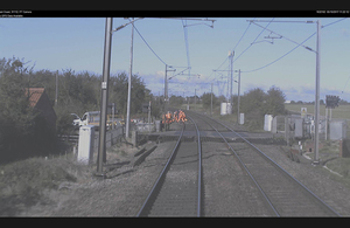Three track workers had to jump clear of a 125mph train with a second to spare because the Person in Charge (PiC) chose to use a warning system as a cue to look out for a train instead of moving off the track.
The shocking finding comes in a report from the Rail Accident Investigation Branch (RAIB) into a near miss incident in October last year between Newark North Gate and Retford on the East Coast Main Line.

CCTV footage showingn the train approaching the workers
The driver of a high speed passenger train approaching the worksite at the maximum permitted speed saw a group of workers in the distance and sounded a warning horn, but saw no response from them.
The track workers became aware of the train about three seconds before it reached them.
One of them group shouted a warning to three others who were between the running rails and cleared the track about a second before the train passed them.
The driver made an emergency brake application before the train passed the point where the group had been working but the train stopped around three quarters of a mile beyond the work site.
The RAIB said the near miss happened because the group had been working under an unsafe and unofficial system of work, set up by the PiC. Instead of the correct method of using the Train Operated Warning System (TOWS) by moving his team to, and remaining in, a position of safety while TOWS was warning of an approaching train, the PiC used the warning as a cue for the lookout to start looking out for approaching trains in order to maximise working time.
This broke down when both the lookout and the PiC became distracted and forgot about the TOWS warning them of the approaching train. Simon French, chief inspector of rail accidents said: ‘When the person in charge of a team is both a strong personality and an employee of the client, it can be particularly hard for contract workers to challenge unsafe behaviour.
‘We have seen this sort of unsafe behaviour before, where the wish to get the work done quickly overrides common sense and self-preservation. When we see narrowly avoided tragedies of this type it is almost always the result of the adoption of an unsafe method of work and the absence of a challenge from others in the group.
‘We are therefore recommending that Network Rail looks again at how it monitors and manages the safety leadership exercised by its staff, and how they interact with contractors. There have been too many near misses in recent years. It takes effective leadership and a positive safety culture to create a working environment in which everyone can be confident that safety will come first.’
The RAIB has also published a report into a derailment in January 2018 (pictured), where a passenger train travelling on a remote section of line between Mallaig and Fort William in north-west Scotland after striking a large landslip.
There were no injuries but some diesel entered nearby Loch Eilt.
The RAIB found that the landslip was triggered by a combination of rainfall and snow melting during a rapid thaw.
It said Network Rail’s processes for managing landslip risk did not take account of the hazard caused by rapidly melting snow, adding that although it is unlikely that a greater understanding of snowmelt risk would have avoided this accident, it could avoid or mitigate an accident in other circumstances.
Register now for full access
Register just once to get unrestricted, real-time coverage of the issues and challenges facing UK transport and highways engineers.
Full website content includes the latest news, exclusive commentary from leading industry figures and detailed topical analysis of the highways, transportation, environment and place-shaping sectors.
Use the link below to register your details for full, free access.
Already a registered? Login